Around Indore


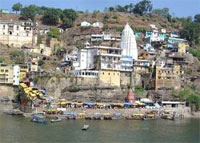
The holy town of Omkareshwar is also about 77 Kms from Indore. It is an island on the river Narmada and Kaveri. This place has hundreds of Hindu / Jain temples. The most important being the one housing one of the twelve Jyotirlingas (Bhagwan Shiv), which has made this.places an important pilgrimage center since ancient times. A boat ride in Narmada River around the island of Omkareshwar is quite enjoyable.
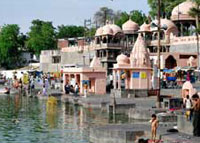
The pilgrimage town of Ujjain is about 56 Kms. From Indore. It traces its origin to the very dawn of Indian history; Hindu astronomy, astrology and geography have Ujjain as the base for calculations, which is the "Greenwich" of Hindu astronomers and astrologers.Situated on the bank of Kshipra, it is one of the oldest holy cities in India. It is place of one of the Kumbh Melas. It was the capital of the Avanti Nagari of Raja Bhoj and poet Kalidas. It had become a great center for learning during the rule of the great legendary king Vikramaditiya.The temple of Mahakaleshwar is one of the twelve Jyotirlingas. Bhartrihari caves, sandipani (Shri Krishna's Guru) Ashram, ancient observatory are some of the places to visit.
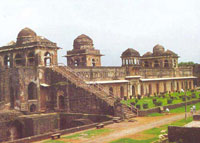
The historical fort of Mandu (Mandav garh or the "city of joy" {shadibad}) is about 90 Kms from Indore. Founded in the 10th century as a fort- capital by the par mar rulers, this extensive, now deserted hilltop fort is one of the most interesting sites in Madhya Pradesh. This is supposed to be the biggest fort in India (82 Kms perimeter) has ruins of lots of palaces, baths, pavilions of the past, when it was a busy town. The tomb of Hoshang Shah is supposed to be the inspiration behind Shah jehan's celebrated Taj Mahal, jahaj Mahal.Hindola Mahal, Ashrafi Mahal are some of the notable monuments. Each of these is an architectural gem in the Afgan style. The legend of the romance of Rani Roopmati and Baj Bahadur haunts this place, which is quite beautiful in rainy season
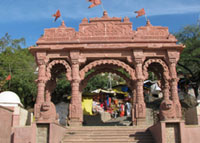
Dewas is 36 Kms from Indore. Its name is derived from a hill in its vicinity known as Devi Vashini, on which is perched a temple of its presiding deity Chamunda Devi. Earliest mention of Dewas is in the epic poem Chandi bardai of 16th century. Most beautiful spot is the Devi hall where there are several temples cut out in rocky walls with images in relief.
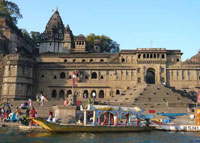
Maheshwar 90 kms from Indore is mentioned in Ramayan and Mahabharat as Mahishmati. It became famous when Rani Ahilya Bai Holkar made it her capital. It is famous for its sarees- Maheshwari sarees known for their unique weaves. he Rajgaddi and Rajwada of Maheshwar have got its historical importance as Devi Ahilya made her capital. On the bank of river there are beautiful ghats like "Peshwa Ghat", "Ahilya Ghat" and "Phanse Ghat". There are famous temples like Kaleshwar Mandir, Raj-Rajeshwar, Vitthaleshwar and Ahilyashwar.
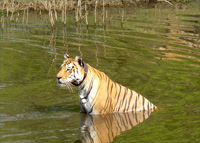
Pench National park, nestling in the lower southern reaches of the Satpuda Hills is named after Pench river, meandering through the park from north to south. It is located on the southern boundary of Madhya Pradesh, bordering Maharashtra, in the districts of Seoni and Chhindwara.Pench National Park, comprising of 758 SQ Kms, out of which a core area of 299 sq kms of Indira Priyadarshini Pench National Park and the Mowgli Pench Sanctuary and remaining 464 sq kms of Pench National Park is the buffer area. The area of the present tiger reserve has a glorious history. A description of its natural wealth and richness occurs in Ain-i-Akbari. Pench Tiger Reserve and its neighbourhood is the original setting of Rudyard Kipling's most famous work, The Jungle Book.
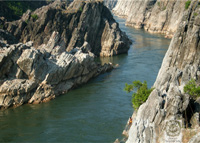
Soaring in glittering splendour, the Marble Rocks at Bhedaghat rise to a hundred feet on either side of the Narmada. The serene loveliness of the scene is one of cool quiet, the sunlight sparkling on the marble-white pinnacles and casting dappled shadows on the pellucid waters. These white rocks with views of black and dark green volcanic seams are truly majestic, and produce a magical effect on moonlit nights. The holy rive flows by tranquilly and is flanked by the towering cliffs which reflect in it like a mirror the changing moods of nature. A little distance away, it becomes turbulent as it plunges in a mighty water fall known as Dhuandhar.

The Sanchi hill goes up in shelves with Stupa 2 situated on a lower shelf, Stupa 1, Stupa 3, the 5th century Gupta Temple No.17 and the 7th century temple No. 18 are on the intermediate shelf and a later monastery is on the crowning shelf. The balustrade surrounding Stupa 2, carved with aniconic representations of the Buddha, was added in the late 2nd century BC under the Satavahanas.
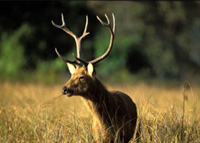
Kanha's sal and bamboo forests, rolling grasslands and meandering streams stretch over 940 sq km in dramatic natural splendour which form the core of the Kanha Tiger Reserve created in 1974 under Project Tiger. This was the park that the Central Indian Barasingha, also known as the hardground barasingha, was brought back from the virtual edge of extinction. By a special statute in 1955, Kanha National Park came into being. Since then, a series of stringent conservation programmes for the protection of the park's flora and fauna has given Kanha its deserved reputation for being one of the finest and best administered National Parks in Asia, an irresistible attraction for all wildlife lovers and a true haven for its animal and avian population.
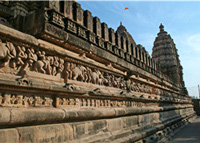
In the temple architecture of India, the Khajuraho complex remains unique. One thousand years ago, under the generous and artistic patronage of the Chandela Rajput kings of Central India, 85 temples, magnificent in form and richly carved, came up on one site, near the village of Khajuraho. The amazingly short span of 100 years, from 950 AD - 1050 AD, saw the completion of all the temples, in an inspired burst of creativity. Today, of the original 85, only 22 have survived the ravages of time; these remain as a collective paean to life, to joy and to creativity; to the ultimate fusion of man with his creator.
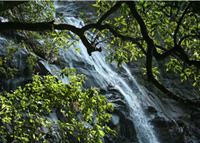
Pachmarhi is Madhya Pradesh's most verdant gem. A lovely hill resort girdled by the Satpura ranges, it offers absolute tranquility. Bridle paths lead into placid forest groves of wild bamboo, jamun, dense sal forests and delicate bamboo thickets Complementing the magnificence of nature are the works of man; Pachmarhi is also an archaeological treasure- house. In cave shelters in the Mahadeo Hills is an astonishing richness in rock paintings. Most of these have been placed in the period 500-800 AD, but the earliest paintings are an estimated 10,000 years old. Much of this ambience has been set, and is still being maintained, by the strong presence of the Army whose Education Corps is headquartered here. The old cottages, meticulously maintained by the Military Engineering Serivces, have changed little since the days of Kipling.
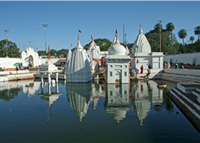
Situated at an altitude of 1065 mt. at the meeting point of the Vindhya and the Satpura mountain ranges amongst sylvan surroundings, Amarkantak is a great pilgrim center for the Hindus, and is the source of the rivers Narmada and Sone. While the Narmada flows Westwards from Amarkantak, the Sone flows towards the East. Amarkantak is indeed blessed by Nature. Holy ponds, lofty hills, forested surroundings, breathtakingly beautiful waterfalls and an ever-pervading air of serenity make Amarkantak a much sought-after destination for the religious-minded as well as for the nature-lover.
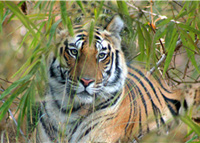
The original home of all the white tigers alive, today, Bandhavgarh was the hunting preserve of the Maharajas of Rewa: their old fort still dominates a hill rising out of the forest. These have been found in the old state of Rewa for many years. The last known was captured by Maharajah Martand Singh in 1951. This White Tiger, Mohan, is now stuffed and on display in the palace of the Maharajas of Rewa.
Copyright © Shri Madan Mahal. All Rights Reserved :: Design & Develop by Sahaj Infotech